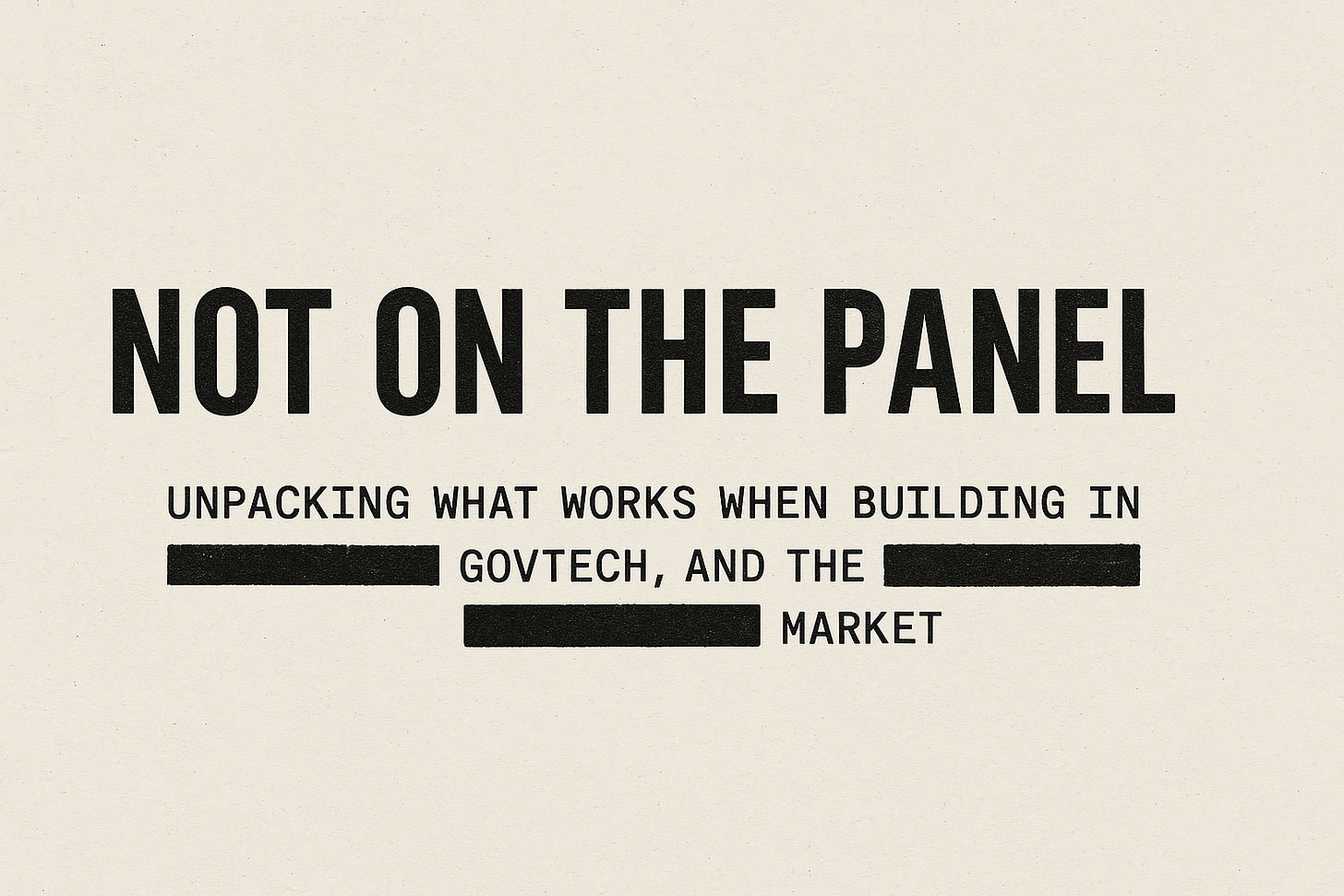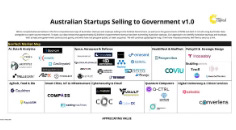Not on the Panel
Unpacking what works when building in ███ ██████, GovTech, and the █████████ market.
👋 Welcome
Welcome to issue #9 of Not on the Panel, your unofficial guide to building and scaling in government. Thank you to the five new subscribers who joined this week. You could be anywhere on the internet right now, but you chose here. That matters.
Not on the Panel tracks the weekly activity in Australia's $80 billion business-to-government market, including who is winning, where the money is going, how the system actually works, and how startups and investors can break in.
We believe the government is not a blocker but one of the biggest untapped platforms for innovation in our region. That is why we are building what we believe is Australia’s first B2G angel syndicate. If you believe in backing bold ideas that solve real problems at scale, come and build with us.
In this week's edition, we look at:
Services Australia seeks partners to improve delivery in remote communities
Foreign tech firms continue to outpace locals in federal contract wins
And in our major features,
Almost a quarter of US unicorns have benefited from government contracts
🤝 If you value our unique perspective, help us grow by sharing it with your network. Every new subscriber brings us closer to delivering more in-depth coverage of the overlooked and undervalued B2G market.
📰 This Week in Global Gov
🏛️ Services Australia Enhances Remote Community Services
Services Australia has expanded its remote servicing teams to meet the needs of 335 remote communities better. This enhancement aims to provide faster and more efficient customer service, ensuring that individuals in remote areas have improved access to government services.
Source: Services Australia
💼 This Week in Australian B2G
Week 23 (ending 30 May)
📄 $1.369b in total reported contract spend
🖥️ $5.618m in software + digital services
Breakdown by Service:
💾 Software: $2.01m
☁️ SaaS (Cloud): $169k
🛠️ Software maintenance & support: $711k
🧱 Platform SaaS: $36k
⚙️ Software/hardware engineering: $0
Breakdown by Procurement Method
📢 Open Tender: $2.72m
🗃️ Prequalified Tender: $0
📩 Limited Tender: $2.90m
GovTech Flex
Octopus Deploy is steadily growing its government footprint, now reaching $209K in total, with a recent $17K addition with the Department of Health. All contracts to date have been secured through limited tenders, which is proof that you don’t always need to be on the panel.
Open Text has landed a new ~$1M contract with the Administrative Appeals Tribunal, bringing its total government haul to nearly $70 million. Of that, $40 million has been earned in the last five years.
🧱Builder Better
🚨 Does Australia’s Government have a startup problem?
Last week, we launched a visual map of Australian startups selling to government. It has already been updated twice. But the real story isn’t the map, it’s what’s missing.
A widening gap between ambition and access. There is a new wave of high-potential Australian startups and a procurement culture that overwhelmingly rewards incumbents and overseas firms.
In the United States and the European Union, governments do more than buy innovation; they help build it. A recent article published in PitchBook found that nearly 25 per cent of US unicorns received federal support through funding, contracts, or partnerships with government agencies.
In 2018, Anduril’s co-founder Trae Stephens even noted a radical but obvious insight:
“It’s ridiculous that almost no venture-backed companies work closely with government, given how many billions it spends.”
We Agree!
Seven years later, Anduril is reportedly raising at a $28 billion valuation, doubling its worth from just months prior. Backed by programs like Project Maven and the Defence Innovation Unit, it has secured more than $170 million in US defence contracts since 2022 alone.
In Australia, that kind of trajectory remains the exception, not the rule.
The pattern is clear. On July 12 last year, three Australian drone startups received $2.2 million each. Just fourteen days later, Anduril secured $22 million in a single contract.
Across the broader timeline, the Commonwealth spent almost $200 million between 2018 and 2025, of which only 10% has gone to early-stage local firms.
In June 2024, the final report from Senator Pocock’s inquiry into Supporting the Development of Sovereign Capability in the Australian Tech Sector confirmed what many in the ecosystem already knew:
A “clear preference” exists within departments for established and foreign suppliers.
This preference is not just short-sighted. It is self-defeating.
Even in software contracts, over the past four years, international firms like Cloudera, Informatica, and Collibra have won over $124 million in Australian government contracts, often outpacing local startups that lack the capital, traction, or support to compete.
Even Atlassian earned sixteen times more federal revenue after its IPO than before.
This is not a reflection of inferior Australian tech.
It’s a reflection of the system it’s trying to grow inside.
The recent $100 million federal commitment to Australian-made drones is a start. But we need more than flickers of support.
That is why we are building our B2G Syndicate: to help investors back the next generation of Australian companies that will scale with government, not around it.
If you missed our startup-to-government map from last week, you can click the thumbnail below and answer a few quick questions to get your copy.
It is not exhaustive, but it is qualified. If we’ve missed a company that meets the criteria, let us know.
This market deserves sharper focus, better data, and real momentum. We are here for all of it.
📣 Are you a Startup Selling to the Government, or want to?
Each week, more than 1,500 federal contracts are published on AusTender. We track what we can, but we cannot review every supplier to identify which companies are startups.
If you’re:
Tendering for government work
Already delivering to a government customer
Recently awarded a contract
We want to hear from you.
You don't need a press release; leave a comment below or get in touch with us.
We are always looking for stories that help explain what is actually happening in the B2G and GovTech markets.
📄 Method and Scope
Each week, we track reported contract data from AusTender, the Commonwealth government’s procurement reporting system. Our focus is on contracts classified under software, SaaS, and digital services, as these categories are most relevant to technology founders building with or for government.
AusTender publishes thousands of contract notices each week across a wide range of categories. While we rely on this data as our primary source, we cannot guarantee the accuracy or timeliness of individual listings.
We do not attempt to cover every sector or supplier. However, if a startup is awarded a contract and we can verify it, we will include it, regardless of classification. These stories help surface where momentum exists and where future opportunity may lie.
✍️Meet the Editor
Hi, I'm Mat, a Startup advisor, former bureaucrat, investor, and lifelong procurement tragic.
Throughout my career, I’ve worked on four of the Commonwealth's most significant non-defence contracts. I remain frustrated that early-stage companies are often excluded from the government market.
This Substack is part of how I’m building in public. I work with founders and investors who see the $80 billion business-to-government opportunity in Australia.
We also support founders in essential but often overlooked areas, such as governance, risk, and strategy.
If you’re a founder looking to break into government or seeking opportunities to back generational companies in this space, please don't hesitate to reach out. I’m always up for a coffee.






